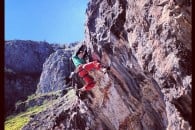How important is good climbing footwear?
I'm sure we can all remember our first pair of climbing shoes – they were comfy weren't they? I remember my first pair coming to the end of the road and being genuinely sad. They were so "good".
But they weren't…
A first-time climber, beginner or even an "improver" (climber) are all easy to spot at the climbing wall. They are either wearing hire shoes or baggy shoes (or both).
Now, when it comes to good footwork, two of the most important aspects are precision and accuracy. The next, pressure. We will explore these aspects in the next videos, but it is simply impossible to place a toe carefully, precisely and beyond all – trust it, with baggy or large shoes.
When watching this video, please don't think there is anything wrong with a hire shoe or a flat "first-time" shoe. They have their place. But, don't buy them with excess space. Don't liken them to trainers or our day-to-day shoe. They must be well fitted – with no excess space. Toes should be touching the end and arguably slightly bent too. This allows us to apply more pressure through the big toe – think full-crimp vs the open-hand grip.
Having spent a fair bit of time with the designers of many shoes, from many brands, they are all adamant about this point. Can you step on a tiny gritstone pebble with a shoe that has space in it? No. Can you really trust your shoe on a 5mm Limestone edge in a shoe that is too "comfy"? No.
Technique is all about efficiency and ultimately, taking the weight off our weakest points – fingers and forearms. If you have shoes that don't fit properly, the weight will go onto your arms because you cannot trust your feet. You will be firing too much, burning out too quickly and you simply will not progress as you want to.
Your first pair of shoes will go through faster than any other, so don't buy the "best", downturned and aggressive shoes. It will be a waste of money. But, do buy them so they are snug. Your foot should completely fill the shoe. It should be tight, arguably slightly uncomfortable to begin with. They may take a few sessions to wear them in but anticipate stretch.
The next five videos will explore what it means to have good footwork. From precision and accuracy, to the position of your heels, pivoting, smearing, toe and heel hooks.
I guarantee there will be elements you have not thought about before, and they will help your footwork and your overall climbing.
Enjoy, and let me know what else you want us to explore beyond footwork and tutorials in drop-knees, the step-through, rock-overs and the inside and outside flag?
Robin O'Leary is a full-time performance coach. He has been working as such for the last 10+years and now works with some of the best-performing athletes in the UK.
Robin is the head coach of the GB Para-Climbing Team and has coached National, European and World Champion climbers. Along with working with top-level athletes around the world, Robin also coaches hundreds of keen enthusiasts. From hands-on technical coaching, to long-term programme work.
Robin is also the co-author of UKClimbing's highly successful Injury Management and Prevention articles.
If you want to get in touch with Robin, please visit his website:



